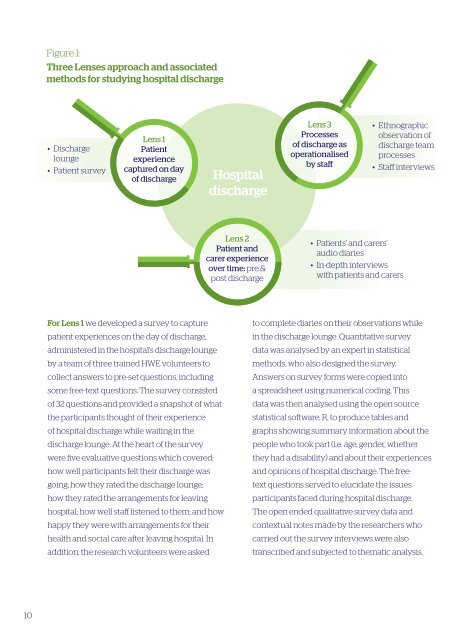Hospital Discharge
3Jzx309Yruj
3Jzx309Yruj
You also want an ePaper? Increase the reach of your titles
YUMPU automatically turns print PDFs into web optimized ePapers that Google loves.
Figure 1:<br />
Three Lenses approach and associated<br />
methods for studying hospital discharge<br />
• <strong>Discharge</strong><br />
lounge<br />
• Patient survey<br />
Lens 1<br />
Patient<br />
experience<br />
captured on day<br />
of discharge<br />
<strong>Hospital</strong><br />
discharge<br />
Lens 3<br />
Processes<br />
of discharge as<br />
operationalised<br />
by staff<br />
• Ethnographic<br />
observation of<br />
discharge team<br />
processes<br />
• Staff interviews<br />
Lens 2<br />
Patient and<br />
carer experience<br />
over time: pre &<br />
post discharge<br />
• Patients’ and carers’<br />
audio diaries<br />
• In-depth interviews<br />
with patients and carers<br />
For Lens 1 we developed a survey to capture<br />
patient experiences on the day of discharge,<br />
administered in the hospital’s discharge lounge<br />
by a team of three trained HWE volunteers to<br />
collect answers to pre-set questions, including<br />
some free-text questions. The survey consisted<br />
of 32 questions and provided a snapshot of what<br />
the participants thought of their experience<br />
of hospital discharge while waiting in the<br />
discharge lounge. At the heart of the survey<br />
were five evaluative questions which covered:<br />
how well participants felt their discharge was<br />
going; how they rated the discharge lounge;<br />
how they rated the arrangements for leaving<br />
hospital; how well staff listened to them; and how<br />
happy they were with arrangements for their<br />
health and social care after leaving hospital. In<br />
addition, the research volunteers were asked<br />
to complete diaries on their observations while<br />
in the discharge lounge. Quantitative survey<br />
data was analysed by an expert in statistical<br />
methods, who also designed the survey.<br />
Answers on survey forms were copied into<br />
a spreadsheet using numerical coding. This<br />
data was then analysed using the open source<br />
statistical software, R, to produce tables and<br />
graphs showing summary information about the<br />
people who took part (i.e. age, gender, whether<br />
they had a disability) and about their experiences<br />
and opinions of hospital discharge. The freetext<br />
questions served to elucidate the issues<br />
participants faced during hospital discharge.<br />
The open ended qualitative survey data and<br />
contextual notes made by the researchers who<br />
carried out the survey interviews were also<br />
transcribed and subjected to thematic analysis.<br />
10


